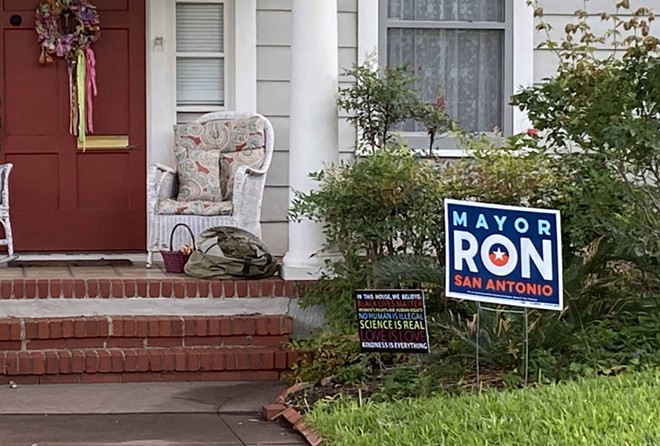
CityScrapes is a column of opinion and analysis.
It's spring in San Antonio. The mountain laurels have bloomed, and the esperanza is starting to grow again. Our lawns, brown and burned out from a brutal summer, are finally turning green.
Front yards also are sprouting the signs for local political candidates that appear in odd-numbered years. Yet the signs for mayoral candidates appear unusually sparse this time.
Mayor Ron Nirenberg appears to have only token opposition. And that's not really a function of his record or the absence of any serious issues or public needs in San Antonio. It's the result of the term limits the voters put into effect in 1991.
A petition effort led by the Homeowner-Taxpayer Association put a term proposition on the ballot back then. The specifics of the HTA effort were draconian: two two-year terms, followed by a lifetime ban. With a broad array of candidates opposing incumbent Mayor Lila Cockrell — from Nelson Wolff and Maria Berriozabal to Van Henry Archer, Jimmy Hasslocher and Kay Turner — the mayoral race and a proposal to halt the proposed Applewhite dam and reservoir project got most of the media attention. Term limits? Not so much.
When the votes were counted, the term limit initiative garnered a massive 65.3% "yes" vote, with majorities from all sectors of the city.
In retrospect, the broad voter support for term limits was easy to understand. For some, it was the spending spree of the Cisneros years, including the development of the Alamodome. Then there was the questionable judgement of then-City Manager Lou Fox in engineering the purchase of a number of downtown buildings including Municipal Plaza, in part from a Houston developer he had personally done business with. And finally, with the Texas oil bust of the late '80s and the drop in city revenues, Mayor Cockrell called for a property tax increase — a hike that was rolled back in a citywide vote.
Over the past two decades, there have been efforts to ease the drastic term limits adopted in 1991. As a result, Nirenberg can now seek a fourth, and final, two-year term. But for potential challengers the political logic is clear. Why fight an incumbent with substantial name recognition and a campaign war chest when you can just wait two years and try for an entirely open seat? In that contest, the only necessity is to rack up just enough votes to get into a runoff with the leader.
So, on May 6, we're left with a limited set of choices for mayor.
It's a far cry from where we were in spring of 2017, when a politically ambitious Nirenberg chose to run for mayor against incumbent Ivy Taylor. In that race, Nirenberg placed a big focus on leadership, criticizing Taylor's "lack of vision" and contending she had never met a lobbyist or developer she didn't like. He stood for a more environmentally sensitive approach to development and potential growth, and he pledged to put a light rail plan on the ballot. Then there was his promise to reform ethics at city hall with an independent "ethics auditor," and rebuild the public's trust in government.
Shortly after his victory in the June 2017 runoff election, the Express-News called on Nirenberg to "deliver... on his bold and inclusive vision." The editorial provided a lengthy list of civic issues, starting with the city's 300th anniversary and "reimagining the Alamo," running through the promise of a vote on a light rail package, innovative policing, luring new employers, getting a Major League Soccer team and "partnering with Austin on rail."
The newspaper's priorities were not necessarily mine, then or now. But San Antonio remains a city that's succeeded in growing in population and spreading outward while remaining poorer and more economically segregated than its peers. The issues that demanded mayoral attention largely remain today.
My concern is not with Nirenberg's promises or his record. It's with a structure of city government — mayors and councilmembers limited and constrained by term limits, electoral participation and attention weakened by the May election date, and indeed the city manager system itself.
The two-year council terms and city manager arrangement that business leaders such as Walter McAllister saw as their means to control city government in 1951 aren't necessarily well suited to the far larger, more diverse and more challenged San Antonio of today.
And while I don't fault local politicos for their ambition, we are today, even more than in 2017, a community that genuinely needs both vision and leadership — and a government that's up to the task.
Heywood Sanders is a professor of public administration at the University of Texas at San Antonio.
Follow us: Google News | NewsBreak | Instagram | Facebook | Twitter

